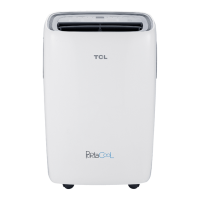Do you have a question about the TCL TAC-12CHS and is the answer not in the manual?
Instructions for ordering replacement parts, including necessary information like model number and part name.
Provides detailed measurements and diagrams for the indoor unit of the air conditioner.
Provides detailed measurements and diagrams for the outdoor unit of the air conditioner.
Illustrates the refrigerant flow and components for heat pump operation of the air conditioner.
Illustrates the refrigerant flow and components for cooling-only operation of the air conditioner.
Specifies the operational voltage range and air flow settings for performance testing.
Lists the key parameters measured and used in performance curve analysis.
Explains the procedure for measuring indoor air wet/dry-bulb temperature difference.
Describes the buttons and basic functions of the remote controller for operating the air conditioner.
Guides users on how to preset the remote controller for cooling-only or heat pump operation.
Details safety mechanisms like time delay, frost prevention, and high-temperature protection.
Explains the operation of 'I Feel', 'COOLING', 'DRY', and 'HEATING' modes.
Describes the defrost cycle and the role of the assistant thermistor in heating capacity.
Details the operation of the fan motor, including auto fan speed and rotational frequency control.
Outlines common failure codes, lamp flashes, and procedures for handling system malfunctions.
Provides an exploded view of the indoor unit components with numerical references.
Provides an exploded view of the outdoor unit components with numerical references.
Classifies air conditioners based on function and installation type.
Explains the key elements of air conditioning: temperature, humidity, purity, and air flow.
Describes the fundamental principles of how a refrigerating cycle works.
Provides definitions for key terms used in air conditioning, such as enthalpy, latent heat, and convection.
Defines common units used in HVAC and provides conversion tables for temperature, area, and weight.
Explains the function of major components like compressor, condenser, evaporator, and dryer.
Details how refrigerant states change on a Mollier diagram during the refrigeration cycle.
Provides examples and steps for drawing a typical refrigerating cycle on a Mollier diagram.
Explains how to calculate refrigerating effect, work of compression, and COP.
Describes how to read and interpret a psychrometric chart to determine air properties.
Explains the Discomfort Index and its correlation with human comfort levels based on temperature and humidity.
Discusses dewing and methods to prevent it, including relative humidity guidelines.
Explains how to calculate combined sound levels and decompose noise sources.
Covers sound attenuation principles and provides tables for allowable noise levels in various environments.
Outlines factors contributing to cooling/heating load, including human body heat and equipment.
Provides a method and table for calculating cooling load based on room characteristics.
Guides on selecting the appropriate air conditioner capacity based on room requirements and considerations.
Focuses on checking power supply, voltage, and wire capacity for proper operation.
Covers checks for insulation resistance, running capacitor, and motor fan for internal components.
Details electrical checks for compressor issues like ground test, wrong wiring, and OLP operation.
Addresses mechanical problems such as compressor not starting, poor compression, or overcurrent.
Lists checks for thermostat, filter, fan, ventilation, heat exchanger, and load conditions.
Analyzes temperature differences to diagnose refrigerant system issues like leaks or overcharging.
Explains normal pressure/temperature values and how to diagnose issues based on deviations.
Describes symptoms and corrective actions for refrigerant shortage, system closing, overcharge, and bad compression.
Provides a flowchart for diagnosing why the entire product fails to operate.
Guides troubleshooting steps for issues related to the indoor room fan not functioning.
Outlines procedures for diagnosing problems with the compressor or outdoor fan.
Addresses troubleshooting for the up/down vane and left/right louvers not operating correctly.
Covers troubleshooting steps when function settings via the remote control are disabled.
Details how to diagnose and resolve issues where the unit fails to switch between cooling and heating modes.
Addresses gas leaks caused by improper pipe cutting and mal-rectangular sections.
Focuses on preventing gas leaks by properly removing burrs after pipe cutting.
Discusses gas leaks and connection issues due to inaccurate sizing during flaring works.
Explains how damaged or improperly fastened flare nuts can cause gas leakages.
Addresses water leaks from inclined indoor units and improperly connected drain hoses.
Covers water leaks caused by improper extending or laying of the drain hose.
Deals with water leaks from upwarded drain hoses or clogged drain hoses.
Addresses water leaks caused by improper insulation on connecting and hidden parts of tubing.
Explains how water drops from tubing and taping can cause leaks.
Discusses cooling capacity reduction due to tube extending and insufficient freon adding.
Addresses cooling capacity reduction due to improper airflow spacing in split ACs.
Addresses cooling capacity reduction due to improper airflow spacing in window ACs.
Covers cooling capacity reduction from improper outdoor unit installation and awning.
Discusses cooling capacity reduction due to crushed or improperly replaced tubing.
Addresses cooling capacity reduction caused by excessive tubing length or height difference.
Deals with noise and vibration from unstably installed units and fittings.
Addresses noise and vibration caused by unstably fixed surplus tubings.
Covers major electrical problems resulting from incorrect wiring in 3-phase power lines.
Discusses major electrical problems caused by poor insulation of connecting cables.
Explains how to prevent bad smells and gases from being discharged through the drain line.
Describes the composition and general behavior of R407c refrigerant.
Highlights key differences in refrigerant charging, composition, leak detection, and temperature trends.
Provides installation instructions specifically for wall-mounted split type air conditioners.
Details refrigerant properties, temperature-pressure relationships, and strong/weak points.
Lists all necessary tools and accessories required for the installation process.
Covers selecting locations, piping, wiring, drainage, air purging, and test running.
Instructions for ordering replacement parts, including necessary information like model number and part name.
Provides detailed measurements and diagrams for the indoor unit of the air conditioner.
Provides detailed measurements and diagrams for the outdoor unit of the air conditioner.
Illustrates the refrigerant flow and components for heat pump operation of the air conditioner.
Illustrates the refrigerant flow and components for cooling-only operation of the air conditioner.
Specifies the operational voltage range and air flow settings for performance testing.
Lists the key parameters measured and used in performance curve analysis.
Explains the procedure for measuring indoor air wet/dry-bulb temperature difference.
Describes the buttons and basic functions of the remote controller for operating the air conditioner.
Guides users on how to preset the remote controller for cooling-only or heat pump operation.
Details safety mechanisms like time delay, frost prevention, and high-temperature protection.
Explains the operation of 'I Feel', 'COOLING', 'DRY', and 'HEATING' modes.
Describes the defrost cycle and the role of the assistant thermistor in heating capacity.
Details the operation of the fan motor, including auto fan speed and rotational frequency control.
Outlines common failure codes, lamp flashes, and procedures for handling system malfunctions.
Provides an exploded view of the indoor unit components with numerical references.
Provides an exploded view of the outdoor unit components with numerical references.
Classifies air conditioners based on function and installation type.
Explains the key elements of air conditioning: temperature, humidity, purity, and air flow.
Describes the fundamental principles of how a refrigerating cycle works.
Provides definitions for key terms used in air conditioning, such as enthalpy, latent heat, and convection.
Defines common units used in HVAC and provides conversion tables for temperature, area, and weight.
Explains the function of major components like compressor, condenser, evaporator, and dryer.
Details how refrigerant states change on a Mollier diagram during the refrigeration cycle.
Provides examples and steps for drawing a typical refrigerating cycle on a Mollier diagram.
Explains how to calculate refrigerating effect, work of compression, and COP.
Describes how to read and interpret a psychrometric chart to determine air properties.
Explains the Discomfort Index and its correlation with human comfort levels based on temperature and humidity.
Discusses dewing and methods to prevent it, including relative humidity guidelines.
Explains how to calculate combined sound levels and decompose noise sources.
Covers sound attenuation principles and provides tables for allowable noise levels in various environments.
Outlines factors contributing to cooling/heating load, including human body heat and equipment.
Provides a method and table for calculating cooling load based on room characteristics.
Guides on selecting the appropriate air conditioner capacity based on room requirements and considerations.
Focuses on checking power supply, voltage, and wire capacity for proper operation.
Covers checks for insulation resistance, running capacitor, and motor fan for internal components.
Details electrical checks for compressor issues like ground test, wrong wiring, and OLP operation.
Addresses mechanical problems such as compressor not starting, poor compression, or overcurrent.
Lists checks for thermostat, filter, fan, ventilation, heat exchanger, and load conditions.
Analyzes temperature differences to diagnose refrigerant system issues like leaks or overcharging.
Explains normal pressure/temperature values and how to diagnose issues based on deviations.
Describes symptoms and corrective actions for refrigerant shortage, system closing, overcharge, and bad compression.
Provides a flowchart for diagnosing why the entire product fails to operate.
Guides troubleshooting steps for issues related to the indoor room fan not functioning.
Outlines procedures for diagnosing problems with the compressor or outdoor fan.
Addresses troubleshooting for the up/down vane and left/right louvers not operating correctly.
Covers troubleshooting steps when function settings via the remote control are disabled.
Details how to diagnose and resolve issues where the unit fails to switch between cooling and heating modes.
Addresses gas leaks caused by improper pipe cutting and mal-rectangular sections.
Focuses on preventing gas leaks by properly removing burrs after pipe cutting.
Discusses gas leaks and connection issues due to inaccurate sizing during flaring works.
Explains how damaged or improperly fastened flare nuts can cause gas leakages.
Addresses water leaks from inclined indoor units and improperly connected drain hoses.
Covers water leaks caused by improper extending or laying of the drain hose.
Deals with water leaks from upwarded drain hoses or clogged drain hoses.
Addresses water leaks caused by improper insulation on connecting and hidden parts of tubing.
Explains how water drops from tubing and taping can cause leaks.
Discusses cooling capacity reduction due to tube extending and insufficient freon adding.
Addresses cooling capacity reduction due to improper airflow spacing in split ACs.
Addresses cooling capacity reduction due to improper airflow spacing in window ACs.
Covers cooling capacity reduction from improper outdoor unit installation and awning.
Discusses cooling capacity reduction due to crushed or improperly replaced tubing.
Addresses cooling capacity reduction caused by excessive tubing length or height difference.
Deals with noise and vibration from unstably installed units and fittings.
Addresses noise and vibration caused by unstably fixed surplus tubings.
Covers major electrical problems resulting from incorrect wiring in 3-phase power lines.
Discusses major electrical problems caused by poor insulation of connecting cables.
Explains how to prevent bad smells and gases from being discharged through the drain line.
Describes the composition and general behavior of R407c refrigerant.
Highlights key differences in refrigerant charging, composition, leak detection, and temperature trends.
Provides installation instructions specifically for wall-mounted split type air conditioners.
Details refrigerant properties, temperature-pressure relationships, and strong/weak points.
Lists all necessary tools and accessories required for the installation process.
Covers selecting locations, piping, wiring, drainage, air purging, and test running.
| Capacity | 1 Ton |
|---|---|
| Cooling Capacity | 12000 BTU/h |
| Functions | Cooling, Heating, Dehumidification, Fan |
| Power Supply | 220-240V, 50Hz |
| Refrigerant | R32 |
| Type | Split |
| Operating Temperature (Cooling) | 18°C to 43°C |
| Noise Level (Indoor Unit) | 38 dB |
| Noise Level (Outdoor Unit) | 52 dB |












